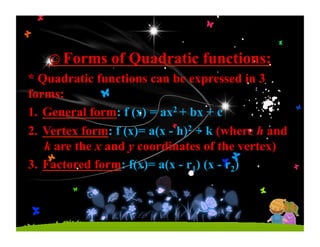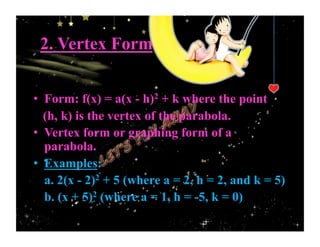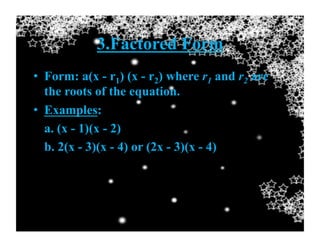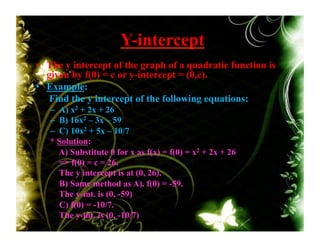Quadraticfunctionpresentation 100127142417-phpapp02
- 1. • A quadratic function (f) is a function that has the form as f(x) = ax2 + bx + c where a, b and c are real numbers and a not equal to zero (or a ≠ 0). • The graph of the quadratic function is called a parabola. It is a "U" or “n” shaped curve that may open up or down depending on the sign of coefficient a. Any equation that has 2 as the largest exponent of x is a quadratic function.
- 2. ☺Forms of Quadratic functions: * Quadratic functions can be expressed in 3 forms: 1. General form: f (x) = ax2 + bx + c 2. Vertex form: f (x)= a(x - h)2 + k (where h and k are the x and y coordinates of the vertex) 3. Factored form: f(x)= a(x - r1) (x - r2)
- 3. 1. General form • Form : f(x) = ax2+ bx+ c • General form is always written with the x2 term first, followed by the x term, and the constant term last. a, b, and c are called the coefficients of the equation. It is possible for the b and/or c coefficient to equal zero. Examples of some quadratic functions in standard form are: a. f(x) = 2x2 + 3x – 4 (where a = 2, b = 3, c = -4) b. f(x) =x2 – 4 (where a = 1, b = 0, c = -4) c. f(x)= x2 ( where a = 1, b and c = 0) d. f(x)= x2 – 8x (where a = ½, b = -8, c = 0).
- 4. 2. Vertex Form • Form: f(x) = a(x - h)2 + k where the point (h, k) is the vertex of the parabola. • Vertex form or graphing form of a parabola. • Examples: a. 2(x - 2)2 + 5 (where a = 2, h = 2, and k = 5) b. (x + 5)2 (where a = 1, h = -5, k = 0)
- 5. 3.Factored Form • Form: a(x - r1) (x - r2) where r1 and r2 are the roots of the equation. • Examples: a. (x - 1)(x - 2) b. 2(x - 3)(x - 4) or (2x - 3)(x - 4)
- 6. Discriminant • Quadratic formula: If ax2 + bx + c, a ≠ 0, x = • The value contained in the square root of the quadratic formula is called the discriminant, and is often represented by ∆ = b2 – 4ac. * b2 – 4ac > 0 → There are 2 roots x1,2= . * b2 – 4ac = 0 → There is 1 real root, x = -b/2a. * b2 – 4ac < 0 → There are no real roots.
- 7. Using Quadratic Formula • A general formula for solving quadratic equations, known as the quadratic formula, is written as: • To solve quadratic equations of the form ax2+ bx+ c, substitute the coefficients a, b, and c in to the quadratic formula. 1. Exercise: Solve 4x2 – 5x + 1 = 0 using the quadratic formula ∆ = b2 – 4ac= 52 – 4(4)(1) = 25 – 16 = 9 => = = ± 3 x x1 = 1 or x2 = 1/4
- 8. Using Factoring • Convert from general form, f(x) = ax2 + bx + c to factored form, a(x - x1) (x - x2) : + Example 1: Solve x2+ 2x = 15 by factoring => x2 + 2x – 15 = 0 (General form) (x + 5)(x - 3) = 0 (Factoring form) x + 5 = 0 or x – 3 = 0 x = -5 or x = 3 → Thus, the solution to the quadratic equation is x = -5 or x = 3. + Example 2: Solve x2 + 5x – 9 = -3 by factoring => x2 + 5x – 6 = 0 (General form) (x – 1)(x + 6) = 0 (Factoring form) x – 1 = 0 or x + 6 = 0 x = 1 or x = -6 → Thus, the solution to the quadratic equation is x = 1 or x = -6.
- 9. Using Completing the Square • Converting from the general form f(x) = ax2+ bx+ c to a statement of the vertex form f(x)= a(x - h)2 + k. • When quadratic equations cannot be solved by factoring, they can be solved by the method of completing the squares. • Example: Solve x2 + 4x – 26 = 0 by completing the square • (x2 + 4x + 4 – 4) – 26 = 0 (General form) • (x + 2)2 – 4 – 26 = 0 • (x + 2)2 – 30 = 0 (Vertex form) • (x + 2)2 = 30 • x + 2 = • x = - 2 • x = - 2 + or x = - 2 -
- 10. Application to higher-degree equations • Example: x4 + 4x2 - 5 = 0 – The equation above can be written as: – (x2)2 + 4(x2) - 5 = 0 – (Quadratic function with exponent x = 2) – Solve: ./ Substitute x2 = P P2 + 4P - 5 =0 (P + 5)(P - 1) = 0 P = -5 or P = 1 ./ Re-substitute P = x2 => P = -5 = x2 = no roots => P = 1 = x2 => x = ± 1
- 11. The Graph of Quadratic Equation • The graph of quadratic equation in the form f(x) = ax2+ bx+ c is a parabola. The parts of the graph of the parabola are determined by the values of a, b, and c. • The most meaningful points of the graph of a parabola are: 1. x-intercepts: The x-intercepts, if any, are also called the roots of the function. They are meaningful specifically as the zeroes of the function, but also represent the two roots for any value of . 2. y-intercept: The importance of the y-intercept is usually as an initial value or initial condition for some state of an experiment, especially one where the independent variable represents time. 3. Vertex: The vertex represents the maximum (or minimum) value of the function, and is very important in calculus and many natural phenomena.
- 12. X-intercepts • The x intercepts of the graph of a quadratic function f given by y = ax2 + bx + c • The x-intercepts are the solutions to the equation ax2 + bx + c = 0 • The x-intercept in the equation f(x) = ax2 + bx + c, can be found in basically two ways, factoring or the quadratic formula. • * Factoring: If f(x) = y = ax2 + bx + c can be factored into the form y = a(x – r1)(x – r2) , then the x-intercepts are r1 and r2 . • Example: y = x2 - 3x - 18 => 0 = x2 – 3x – 18 (Set y = 0 to find the x – intercept) 0 = (x – 6)(x + 3) (Factor) x – 6 = 0 or x + 3 = 0 x = 6 or x = -3 ( Solved the equation => x – int. = (6, 0) ; (-3, 0) ) • * Quadratic formula: For any function in the form y = ax2 + bx + c, x- intercepts are given by: ( , 0) • Example: y = 2x2 + 5x + 3 (a = 2; b = 5; c = 3 ) => 0 = 2x2 + 5x + 3 (Set y = 0 to find x – int. ) x = ( Using Quadratic formula to solve the equation) x = -5 ±1/4 => x = -19/4 or x = -21/4 (Simplified the equation => x – int. = (-21/4, 0) or (-19/4, 0)).
- 13. Y-intercept • The y intercept of the graph of a quadratic function is given by f(0) = c or y-intercept = (0,c). • Example: Find the y intercept of the following equations: – A) x2 + 2x + 26 – B) 16x2 – 3x – 59 – C) 10x2 + 5x – 10/7 * Solution: A) Substitute 0 for x as f(x) = f(0) = x2 + 2x + 26 => f(0) = c = 26. The y intercept is at (0, 26). B) Same method as A). f(0) = -59. The y-int. is (0, -59) C) f(0) = -10/7. The y-int. is (0, -10/7)
- 14. The Vertex • The vertex can be found by completing the square, or by using the expression derived from completing the square on the general form. • Formula given by: y = ax2 + bx + c So the vertex is • Example: h = -12x2 + 168x – 38 • => -b/2a = -168/2(-12) = 7 (applied the formula to find x-coordinate of vertex of the quadratic equation). • Substitute for x (x = 7) into the original equation. We have that: h = -12(7)2 + 168(7) – 38 = 550 • Thus, the vertex of the equation is (7, 550).
- 15. Graphing Parabola • There are several steps to do before we sketch a graph of parabola of the quadratic equation. • The most easiest way to sketch the graph is from vertex form. • Steps: 1. We need to check whether the graph is concave up if a > 0 (U- shaped) or concave down if a < 0(n-shaped). 2. We need to find the vertex of the equation by the formula x =-b/2a or by the vertex form. 3. We need to find the values of x and y intercepts. + Substitute x = 0 into the equation then find the coordinate of y value. + Let y = 0 then find the values of x.
- 16. Graphing Parabola • Graph the function f(x) = 2x2 + 8x +7 Solution: 1. Write the function f(x) = 2x2 + 8x + 7 in the form f(x) = a (x - h) 2 + k by completing the square. (h, k) f (x) = 2x2 + 8x + 7 => f (x) = 2 (x2 + 4x) + 7 => f (x) = 2 (x2 + 4x + 4) + 7 – 8 => f (x) = 2 (x + 2)2 – 1 3. The function f (x) = 2x2 + 8x + 7 has vertex at (-2, -1) with a horizontal shift of 2 units to the left and a vertical shift of one unit downward. Also since a = 2 > 0 then the graph is concave up. 4. The x-intercept of the function are determined by letting f (x) = 2 (x + 2)2 – 1 = 0 and solving for x as illustrated below:
- 17. Continued f (x) = 2 (x + 2)2 – 1 = 0 => (x + 2)2 = ½ => x + 2 = ± √½ = ± 1/√2 => x = -2 ± (1/√2) 4. The y-intercept is f (0) = 2 (0 + 2)2 – 1 = 7 * The graph of f (x) = 2x2 + 8x +7 is illustrated below:
- 19. Helpful Links • h#p://www.douglas.bc.ca/services/learning-‐ centre/pdf/math/ MA7_30_QuadraBc_EquaBons_and_FuncBons .pdf • h#p://www.cimt.plymouth.ac.uk/projects/ mepres/book9/y9s17ex.pdf • h#p://www.tech.plym.ac.uk/maths/ resources/PDFLaTeX/quad_graphs.pdf • h#p://www.neufeldmath.com/ss/Plus/ Graphing%209.pdf



















